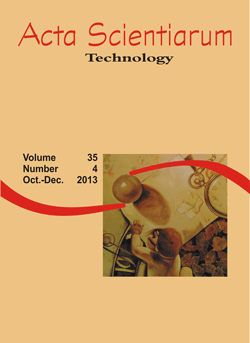<b><i>In vivo</i> toxicological evaluation of crude sulfated polysaccharide from the green seaweed <i>Caulerpa cupressoides</i> var. <i>lycopodium</i> in Swiss mice</b> - doi: 10.4025/actascitechnol.v35i4.15699
DOI:
https://doi.org/10.4025/actascitechnol.v35i4.15699Palavras-chave:
Caulerpaceae, green alga, sulfated polymers, toxicity, systemic evaluationResumo
Seaweeds are widely consumed as vegetables and medicinal products. The green seaweed Caulerpa cupressoides var. lycopodium sulfated polysaccharides (SPs) demonstrated anticoagulant (in vitro) and anti- and prothrombotic (in vivo) effects. However, their toxicity in vivo has not been fully determined. This study evaluated their toxicity in vivo in male Swiss mice. Animals (20-26 g, six group-1) received crude SP (9 mg kg-1, i.p.) or 0.9% saline (0.1 mL 10 g-1, i.p.) for 14 consecutive days, and then analyzed the wet weight of animal´s body organs-1 and biochemical/hematological parameters. Histopathological evaluation was also performed related to crude SP treatment. The results showed that crude SP did not cause toxicity and mortality. Regarding the biochemical analyses, crude SP did not lead to hepatic or renal dysfunctions, but affected (p < 0.05) the platelet count (1530.75 ± 1.05 í— 103 µL-1) compared with the control (969.75 ± 0.51 í— 103 µL-1) according to the hematological evaluation. Although histological changes in the liver and kidney have occurred, results suggested reversibility. The increased spleen size (p < 0.05) also had no toxicological significance based on histopathological analysis. Therefore, crude SP from C. cupressoides could represent safe pharmacological tool in future studies on immunomodulation and thrombosis in vivo.
Â
Â
Downloads
Downloads
Publicado
Como Citar
Edição
Seção
Licença
DECLARAÇíO DE ORIGINALIDADE E DIREITOS AUTORAIS
Declaro que o presente artigo é original, não tendo sido submetido í publicação em qualquer outro periódico nacional ou internacional, quer seja em parte ou em sua totalidade.
Os direitos autorais pertencem exclusivamente aos autores. Os direitos de licenciamento utilizados pelo periódico é a licença Creative Commons Attribution 4.0 (CC BY 4.0): são permitidos o compartilhamento (cópia e distribuição do material em qualqer meio ou formato) e adaptação (remix, transformação e criação de material a partir do conteúdo assim licenciado para quaisquer fins, inclusive comerciais.
Recomenda-se a leitura desse link para maiores informações sobre o tema: fornecimento de créditos e referências de forma correta, entre outros detalhes cruciais para uso adequado do material licenciado.



















